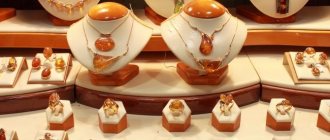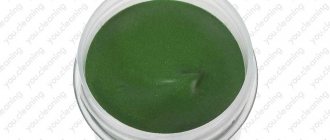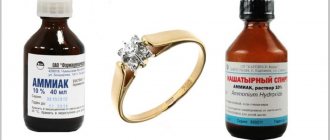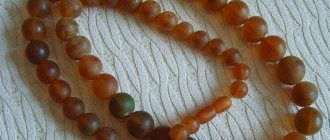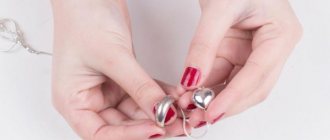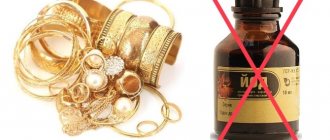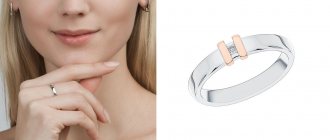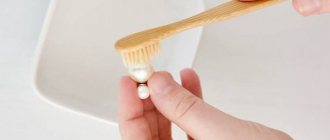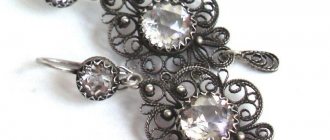What does coral color look like?
According to colorists, coral is a pink-orange color that is a youthful and energetic orange shade of pink. Coral color combines shades of yellow, orange, fawn, and red. It represents a transitional boundary in the spectrum of orange and red.
Interesting materials:
Which is better, a contact grill or an air fryer? What is better: a short piston stroke or a long one? What is better eyebrow dye or henna? What is better than olives with pits or without pits? Which is better, fiber or copper? What is better: Certificate of Merit or Diploma? What is better to plant on virgin soil? What is better to plant after harvesting? What is better: radiator or fan heater? What's better, a scooter or a BMX?
How to Clean and Polish Coral
How to clean, store and polish your coral jewelry. Here are some helpful tips for those who want shiny coral ♦︎ Coral jewelry is very beautiful. But how are they cleaned? And how can you store coral jewelry? Here are tips for cleaning and storing your coral jewelry. Coral. Before you learn how to clean and preserve corals, it's good to have a background. Coral is usually considered as a single material. But this is not the case: it consists of thousands of small identical organisms, genetically called polyps (they are not clearly polyps with tentacles and suckers): their secretions of calcium carbonate form a durable structure. This is to understand why corals are so unique, but also very delicate. However, just like pearls, you should wear coral often. Opaque coral. Over time, corals can often become opaque. The shine of a recently purchased piece of jewelry disappears and remains a non-reflective surface. This is because the surface polish on the coral obtained during production by the artisan who made the gemstone was removed from everyday use. Destruction of coral includes, but is not limited to, sweat, skin acidity and cosmetic substances. Therefore, if you want to wear a coral necklace, keep it away from body creams, perfumes and deodorants. Another tip: avoid keeping the coral in sunlight, too much heat can ruin it. It is better to keep coral pearls in a box indoors. Cleaning methods. Coral is a delicate material that must be handled with care. One method of cleaning coral is to immerse it in a tank of water and dissolve a few drops of detergent. Some people recommend ammonia, but it should be used with caution because it can destroy the gemstone. After bathing the coral for about half an hour, you can run a cloth or use a cotton swab to remove any dirt that has softened in the wash. How to polish coral. If the coral is very damaged, the polishing is the same as the source, it is better to contact Orpheis. Another less risky method is to use plain olive oil: pour a few drops onto a soft cloth and pass the cloth over the coral. To prevent it from becoming opaque, twice a year you can rub the coral into a cotton cloth, perhaps soaked in liquid wax, not too vigorously. In the case of a necklace, a good habit is to also change the inner thread to the gemstone every two or three years.
Chantecler, orecchini in oro rosa, con cinque elementi in corallo rosso e diamanti bianchi
Anello con corallo, oro e diamanti di Ciaravolo
Collana di corallo rosa
Confuorto, orecchini con corallo rosso
Orecchini in corallo rosso e brillanti
Collezione Aucella Luxury, in oro 18kt con corallo rosso, rosa e bianco naturale, diamanti e pietre preziose
Relief background
Unfortunately, soaking a large decoration with a relief background will be quite problematic. Therefore, to clean algae, you need to use a regular dishwashing brush with fairly soft bristles so as not to damage the decoration. For faster cleaning, you can use salt or soda.
Be sure to rinse well afterwards. It should be noted that you cannot clean out all the plaque in 5 minutes; you need to be patient and do everything efficiently.
Also for this purpose, you can get catfish such as ancistrus, sturisom or otocinclus, which will promptly clean the decorations from algae, preventing them from growing.
Prevention is the key to beauty
In order for your accessories to look presentable, they must be carefully looked after. But how do you know when exactly to clean?
To do this, you need to carefully monitor the condition of your jewelry. Every time you open your box, pay attention to the tone of the enamel and decorative inserts, the color of the stones, the presence of dust or plaque, and dirt. Any of these signs is a signal that the products need to be cleaned. However, they can be minimized. To do this, you just need to follow simple rules:
- wear accessories as carefully and carefully as possible, do not drop them . When putting on several things at the same time, try to arrange them so that they do not touch;
- Try on jewelry after you've finished choosing clothes. Otherwise, they can get caught on the fabric, ruining your favorite outfit, lose one or more stones, and even injure you by scratching you with sharp edges!
- for the same reasons, it is not recommended to wear beads, pendants and bracelets before visiting the gym . The only exception is the miniature stud earrings;
- Avoid contact with liquids. Perfume, spray deodorants, and fumes from household chemicals are especially harmful. Chlorinated pool water or the air of a spa salon saturated with moisture and chemical compounds can also have a negative effect. For example, silver jewelry with amber may become irreversibly darkened from such influences, and those covered with gold may peel off;
- overheating negatively affects the clarity and transparency of gemstones . Therefore, it is better to remove all pendants, rings and bracelets before going to the sauna, cooking or walking on the beach - under the influence of excessively high temperatures, minerals can change color or even crack;
- Do you like casual style pendants attached to a rubber band, or similar bracelets? For vacation, it is better to choose other accessories, because salt water and sea air will instantly destroy the flexible base;
- create optimal storage conditions for your jewelry (more on this below).
Getting to know the cockatiel
Due to the characteristic crest and strong beaks of Australian parrots, the nymph corella is classified as a member of the cockatoo family, but is classified as a separate subspecies. In Europe, nymphs appeared in the 30s of the 19th century, and the first cockatiels began to be imported to Russia only in the middle of the 20th century. And now these birds are becoming increasingly popular among bird lovers.
Corellas in their natural habitat like to spend a lot of time on the dry trunks of dead trees, and against such a background, thanks to the colors of their plumage, they are perfectly camouflaged from enemies. The natural color of parrots is dark olive-gray, with a brownish tint. The front of the head, crest and cheeks are different shades of yellow. A charming “blush” stands out on the cheeks - specks of orange-red or pale brown.
Males are quite bright, females have duller plumage.
Nymph parrots are medium-sized birds, reaching 30-33 cm in length, 14-16 cm on the tail, and weighing 100 grams.
The ease of breeding cockatiels at home has led to the emergence of color varieties ranging from pure white to yellow birds with red eyes.
According to reviews from owners, these birds have a high level of intellectual development, are well trained in human speech and reproduce it in a very original way. Caring for cockatiels is not difficult, the main thing is to provide them with optimal living conditions. What will allow the bird to live with you long enough: the average life expectancy of cockatiels in captivity is 16-18 years.
Color correction
The color of a coral depends on its organic and inorganic content and the amount of light it receives during growth. The color of corals is rarely uniform. The most valuable are corals of dark and bright red shades, salmon color, light pink, golden, black and blue. Only a small part has a bright color. To obtain a more intense tone, pale, lightly colored corals are treated with dyes. After color correction, the corals are shaped. Due to their relative softness, corals are easy to machine with steel tools.
rice. Bleached coral and dyed coral
Cleaning with baking soda
For severe stains, you can also use baking soda. To do this, you need to apply baking soda to the wet decor in any convenient way (preferably with a toothbrush) so that it looks like it’s “covered with porridge.” Leave for 20-30 minutes, then rinse with warm water. To remove any remaining plaque, you can lightly brush the area.
Sometimes, due to these cleaning methods, some algae still remains on the decorations. Don't worry about this. After immersing the decor back into the aquarium over the next few days, the green coating will definitely disappear by itself.
Impregnation
To obtain an ideal coral surface, impregnation is used. The material is given a marketable appearance: imperfections (cracks and holes) are removed and prepared for polishing. For this purpose, colored waxes, epoxy resin or so-called stabilizing plastic are used. Some rare types of coral used for jewelry need to be soaked. For example, black coral does not have a calcite skeleton, so it is brittle and fragile. If you do not use impregnation, the beads made from it will break. Ideal quality stony corals, which are very rare, do not require soaking.
Whitening
Every aquarium owner has tried to clean pebbles from annoying green, diatoms, blue-green and other algae with a brush. The process is quite long and painstaking. It will be much easier to use the well-known “Whiteness”. Dilute warm (or even hot) water with bleach in a ratio of 10:1.
Next, leave the stones in this liquid for 1-2 hours. You will be surprised at the results. Your decorations will be completely cleaned of all contaminants. If initially there is a lot of plaque, it is recommended to first lightly clean the pebbles with a sponge or toothbrush.
It is important that after this procedure a good rinsing of the decor under running water is required. This should be done until the smell of chlorine goes away (more than an hour).
The method described above is very effective, even sandstone will become “like new” as a result. But it is not suitable for all types of decoration. For example, white spots may appear on dark stones. Also, whiteness should not be used to clean driftwood, clay and silicone products. They are usually cleaned under running water using a stiff brush.
General rules for caring for precious stones
All gems need recharging, so jewelry with inserts made of natural stones needs to be “walked.” When in contact with a warm human body, minerals come to life. For jewelry that is worn regularly, you need to have special holders . They are located away from heating devices, sources of artificial and natural light.
Solution for cleaning sapphires, alexandrites, rubies – water 500 ml, 1 tsp. ammonia
Rarely worn rings, earrings, beads, necklaces with gems should be packed in separate bags made of natural silk or velvet, placed in a dresser drawer, and placed in boxes. It must be remembered that jewelry with emeralds, chrysolites and other soft and organic stones are susceptible to mechanical damage.
Jewelry with precious stones must be removed every evening; they cannot be left in the bathroom; they are harmed by the humid environment of saunas, swimming pools, baths, and beaches. Moisture causes most gems to fade. Citrines, amethysts, and turquoise fade .
Interesting facts about corals:
- Arabian corals were widely used in the decoration of the Taj Mahal mausoleum, India.
- Precious items made of red coral by Italian masters of the 17th and 18th centuries can be viewed in the Hermitage, St. Petersburg. Particular attention should be paid to the harlequin figurine, which is richly decorated with gold, emeralds and enamel.
The wealth that the sea gave humanity is a nugget of coral, bright, warm, exciting. A coral talisman will help you find balance and be in a positive mood, and will also protect you from envious people and the evil eye.
